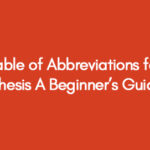
How to Write a Critical Analysis? | A Step-by-Step Guide
July 27, 2023
Table of Abbreviations for Thesis: A Beginner’s Guide
August 3, 2023References are an important aspect of academic writing, and they add credibility and reliability to scholarly work. Among various referencing styles, footnote referencing holds a significant place.
This article will explore the intricacies of footnote reference styles, their importance, how to use them effectively, and much more.
Table of Contents
- What is a Footnote Citation
- Footnote Referencing Examples
- Importance of Footnote Referencing in Academic Writing
- Types of Footnote Referencing Styles
- How to Use Footnote Referencing
- Advantages of Footnote Referencing
- Disadvantages of Footnote Referencing
- Tips for Effective Footnote Referencing
- Common Mistakes to Avoid in Footnote Referencing
- Conclusion
- FAQs
What is a Footnote Citation?
The footnote citation is a refereeing style that use in academic writing to acknowledge the sources used in the document. It involves placing a number or symbol at the end of a sentence or phrase, corresponding to a footnote at the bottom of the page or the end of the document. The purpose of a footnote is to allow readers to locate and verify the sources easily.
Footnote Reference Example
Using footnote style correctly is essential to maintain the integrity of academic work.
Let's explore how to use footnote referencing examples for different types of sources:
Citing Books
When referencing a book in a footnote, include the author's name, book title, publication year, publisher, and page number.
Example: ^1 J. Doe, "The Art of Academic Writing," 2023, XYZ Publishers, 45.
Citing in Research Paper
For research paper writing, include the author's name, article title, journal name, volume, issue, publication year, and page numbers.
Example: ^2 A. Smith, "Importance of Footnote Referencing," Journal of Academic Studies, 10(2), 2022, 25-30.
Citing Websites
When citing a website, provide the author (if available), the title of the webpage, the website name, the publication or revision date, and the URL.
Example: ^3 J. Johnson, "History of Footnote Referencing," Academic Resources, last updated June 2023.
Also review
Importance of Footnote Referencing in Academic Writing
Proper referencing using footnotes is crucial in academic writing for several reasons. Firstly, it gives credit to the original authors and prevents plagiarism. Secondly, it enables readers to access the cited sources for further research and validation. Thirdly, it enhances the overall credibility of the paper and demonstrates the depth of research undertaken by the writer.
Types of Footnote Referencing Styles
Various academic disciplines may follow different footnote types of referencing for dissertation, report, or thesis writing. Some of the most common styles include:
-
Chicago Style
The Chicago style of footnote referencing is widely used in history, literature, and arts-related subjects. It utilizes superscript numbers to indicate footnotes, which are then listed at the bottom of each page or at the end of the document. If you ask which citation style uses footnotes, the answer is Chicago citation style uses footnotes for referencing sources in academic writing.
-
APA Style
The American Psychological Association (APA) style is prevalent in social sciences and psychology. It uses an in-text citation system with author-date references, but it also allows for footnote citations in certain cases. You may also review the following links;
-
MLA Style
The Modern Language Association (MLA) style is commonly used in humanities and liberal arts subjects. It relies on parenthetical in-text citations, but like the APA style, it also permits the use of footnotes.
-
Harvard Style
The Harvard style is popular in various disciplines and uses an author-date system for in-text citations. However, footnotes can be employed when additional explanations or comments are necessary.
-
Turabian Style
The Turabian style is a variation of the Chicago style and is commonly used in academic writing. It follows similar guidelines for footnotes and bibliographies.
Advantages of Footnote Referencing
Footnote referencing offers several benefits to academic writers.
- Allows readers to locate the exact source of information easily
- Enhances the credibility and authority
- Promotes a standardized and organized approach to citing sources
Disadvantages of Footnote Referencing
Despite its advantages, footnote referencing also has some drawbacks.
- Frequent footnotes could disrupt reading flow.
- Additionally, some academic fields prefer other citation styles, which may create confusion or inconsistencies.
Tips for Effective Footnote Referencing
To ensure effective use of footnote referencing, consider the following tips:
- Always follow the specific style guide recommended by your academic institution.
- Double-check the accuracy of footnotes to avoid errors.
- Use footnotes sparingly and only when additional information is necessary.
- Keep the formatting consistent throughout the document.
Common Mistakes to Avoid in Footnote Referencing
Mistakes in footnote referencing can impact the credibility of your work. Avoid these common errors:
- Incorrect placement of footnotes.
- Missing important bibliographic details in footnotes.
- Using footnotes for referencing instead of in-text citations (when required).
Conclusion
Footnote referencing is a valuable tool in academic writing that enhances the quality and reliability of research papers. By acknowledging the sources used and providing additional context, footnote referencing ensures that scholarly work stands on a solid foundation of credible information.
FAQs
What Citation Uses Footnotes?
The Chicago citation style is the one that uses footnotes for referencing sources in academic writing.
What is the Footnote Citation Format?
The footnote citation format typically follows this pattern:
Author's First Name, Last Name, Title (Place of Publication: Publisher, Year), Page Number/Volume Number, Issue Year.
What is One Benefit to Using Footnotes?
Help to maintain the readability and coherence of the document while still providing important context or references to the reader.
Get 3+ Free Custom Topics within 24 hours;
Get an Immediate Response
Discuss your custom requirements with our writers
Free Online Plagiarism Checker For Students
We will email you the report within 24 hours.
Upload your file for free plagiarism





























